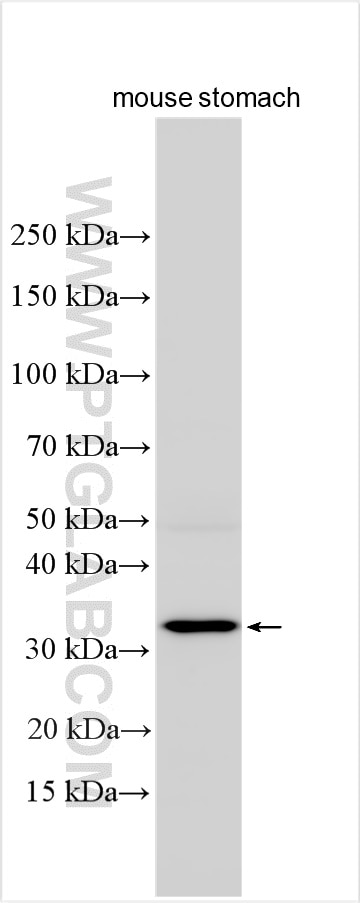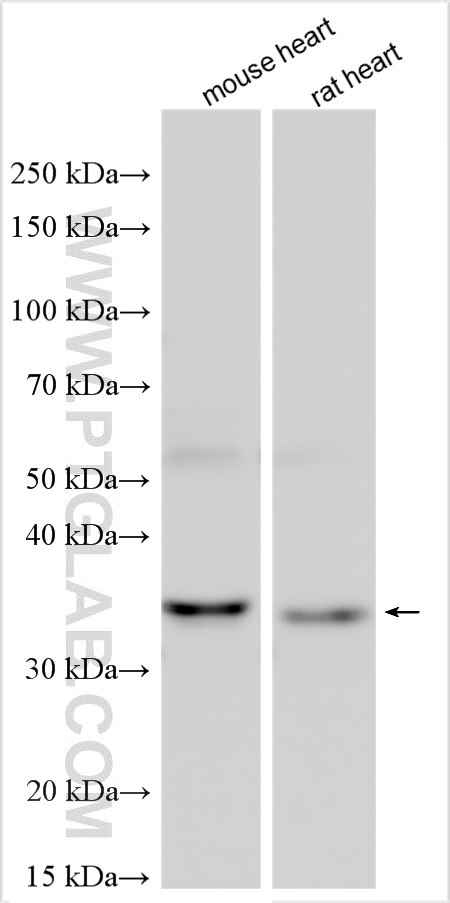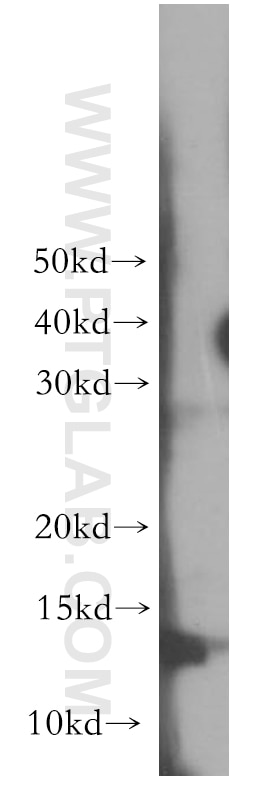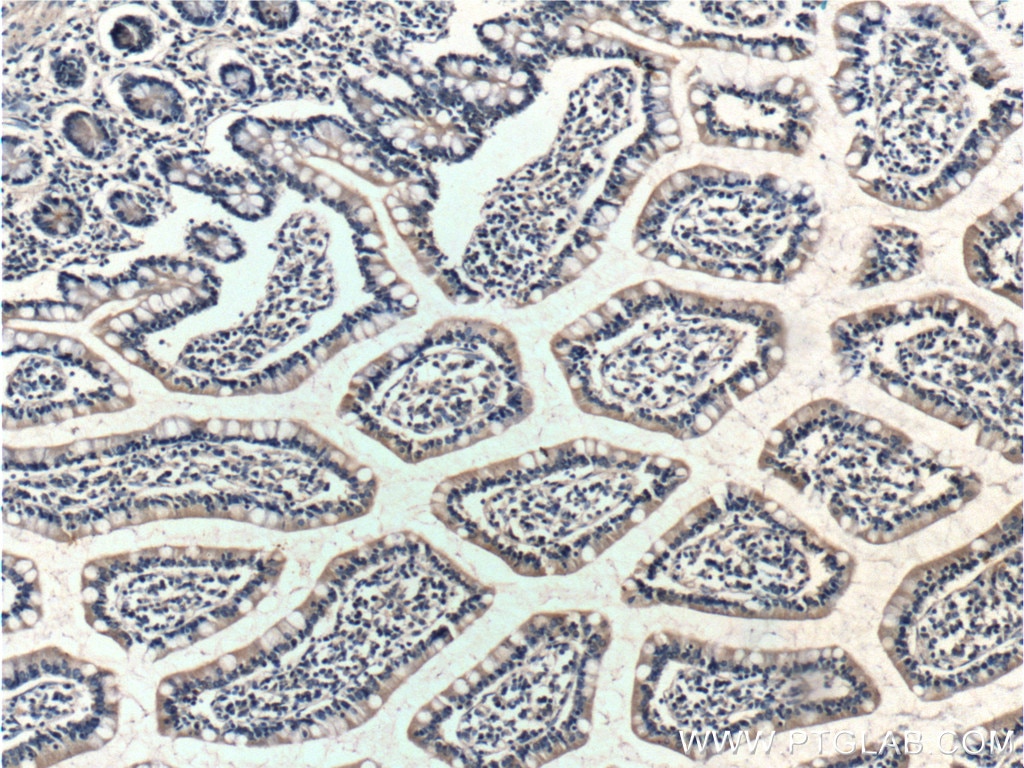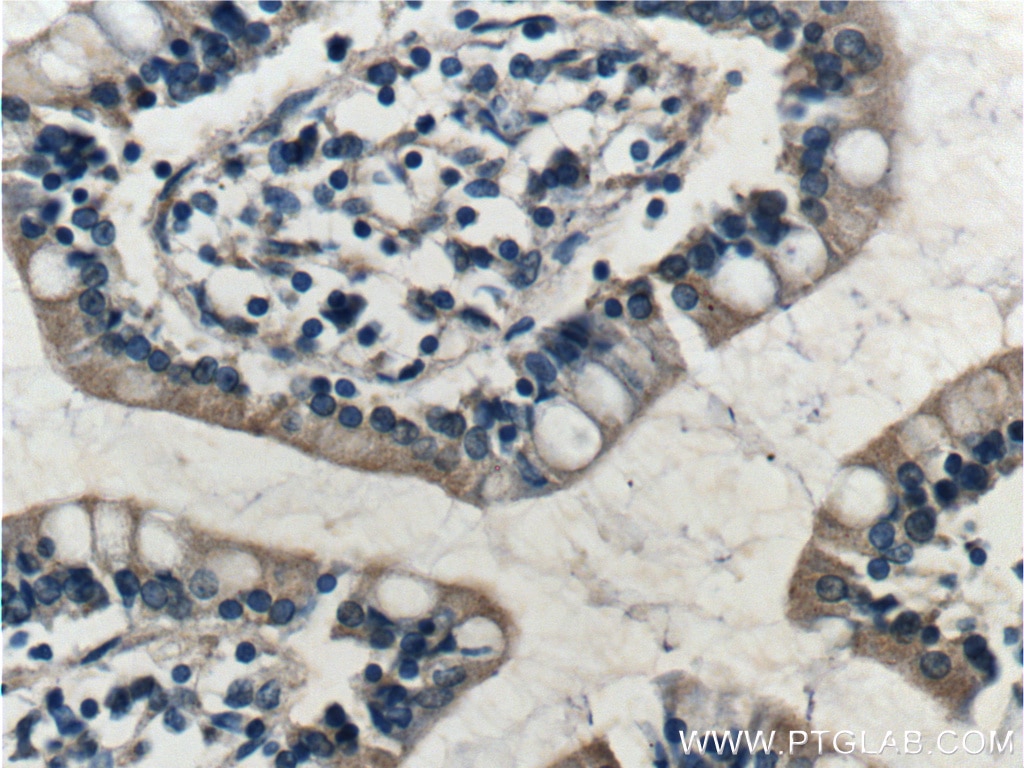Tested Applications
| Positive WB detected in | mouse heart tissue, human heart tissue, mouse stomach tissue, rat heart tissue |
| Positive IHC detected in | human small intestine tissue Note: suggested antigen retrieval with TE buffer pH 9.0; (*) Alternatively, antigen retrieval may be performed with citrate buffer pH 6.0 |
Recommended dilution
| Application | Dilution |
|---|---|
| Western Blot (WB) | WB : 1:500-1:3000 |
| Immunohistochemistry (IHC) | IHC : 1:50-1:500 |
| It is recommended that this reagent should be titrated in each testing system to obtain optimal results. | |
| Sample-dependent, Check data in validation data gallery. | |
Published Applications
| WB | See 3 publications below |
| IHC | See 3 publications below |
| IF | See 4 publications below |
Product Information
10327-1-AP targets RAMP1 in WB, IHC, IF, ELISA applications and shows reactivity with human, mouse, rat samples.
| Tested Reactivity | human, mouse, rat |
| Cited Reactivity | human, mouse, rat |
| Host / Isotype | Rabbit / IgG |
| Class | Polyclonal |
| Type | Antibody |
| Immunogen |
CatNo: Ag0402 Product name: Recombinant human RAMP1 protein Source: e coli.-derived, PGEX-4T Tag: GST Domain: 1-148 aa of BC000548 Sequence: MARALCRLPRRGLWLLLAHHLFMTTACQEANYGALLRELCLTQFQVDMEAVGETLWCDWGRTIRSYRELADCTWHMAEKLGCFWPNAEVDRFFLAVHGRYFRSCPISGRAVRDPPGSILYPFIVVPITVTLLVTALVVWQSKRTEGIV Predict reactive species |
| Full Name | receptor (G protein-coupled) activity modifying protein 1 |
| Calculated Molecular Weight | 17 kDa |
| Observed Molecular Weight | 14 kDa, 33-35 kDa |
| GenBank Accession Number | BC000548 |
| Gene Symbol | RAMP1 |
| Gene ID (NCBI) | 10267 |
| RRID | AB_2269270 |
| Conjugate | Unconjugated |
| Form | Liquid |
| Purification Method | Antigen affinity purification |
| UNIPROT ID | O60894 |
| Storage Buffer | PBS with 0.02% sodium azide and 50% glycerol, pH 7.3. |
| Storage Conditions | Store at -20°C. Stable for one year after shipment. Aliquoting is unnecessary for -20oC storage. 20ul sizes contain 0.1% BSA. |
Background Information
RAMP1 (receptor-activity-modifying protein) is a member of the RAMP family of single-transmembrane-domain proteins which consist of an N-terminal extracellular domain, a transmembrane region, and a short intracellular C-terminal tail. RAMPs are required to transport calcitonin-receptor-like receptor (CRLR) to the plasma membrane. CRLR, a G protein-coupled receptor, can function as either a calcitonin gene-related peptide (CGRP) receptor or an adrenomedullin receptor, depending on which members of the RAMP family are expressed. RAMP1 transports the CRLR to the plasma membrane and then remains associated with it to function as a terminally glycosylated CGRP receptor, while RAMP2 and RAMP3 transfer the CRLR to the cell surface to generate receptors that are preferentially selective for adrenomedullin. RAMP1 can form a homodimer which migrates at 30-37 kDa on SDS-PAGE. (PMID: 9620797; 16188935; 12051717;PMID: 18384073)
Protocols
| Product Specific Protocols | |
|---|---|
| IHC protocol for RAMP1 antibody 10327-1-AP | Download protocol |
| WB protocol for RAMP1 antibody 10327-1-AP | Download protocol |
| Standard Protocols | |
|---|---|
| Click here to view our Standard Protocols |
Publications
| Species | Application | Title |
|---|---|---|
Int J Mol Sci The Role of TRPV1/CGRP Pathway Activated by Prevotella melaninogenica in Pathogenesis of Oral Lichen Planus | ||
J Virol CGRP inhibits SARS-CoV-2 infection of bronchial epithelial cells, and its pulmonary levels correlate with viral clearance in critical COVID-19 patients | ||
J Headache Pain Calcitonin gene-related peptide receptor antagonist BIBN4096BS regulates synaptic transmission in the vestibular nucleus and improves vestibular function via PKC/ERK/CREB pathway in an experimental chronic migraine rat model. | ||
Front Pharmacol Effect of Xiongmatang Extract on Behavioral and TRPV1-CGRP/CGRP-R Pathway in Rats With Migraine. | ||
Neurosci Lett Calcitonin gene-related peptide differentially regulates gene and protein expression in trigeminal glia cells: findings from array analysis. | ||
PLoS One Suppression of mechanical hypersensitivity and change in the expression of the dopamine D2 receptor by administration of anti-CGRP antibody into the trigeminal ganglion in trigeminal neuropathic pain model rats |

